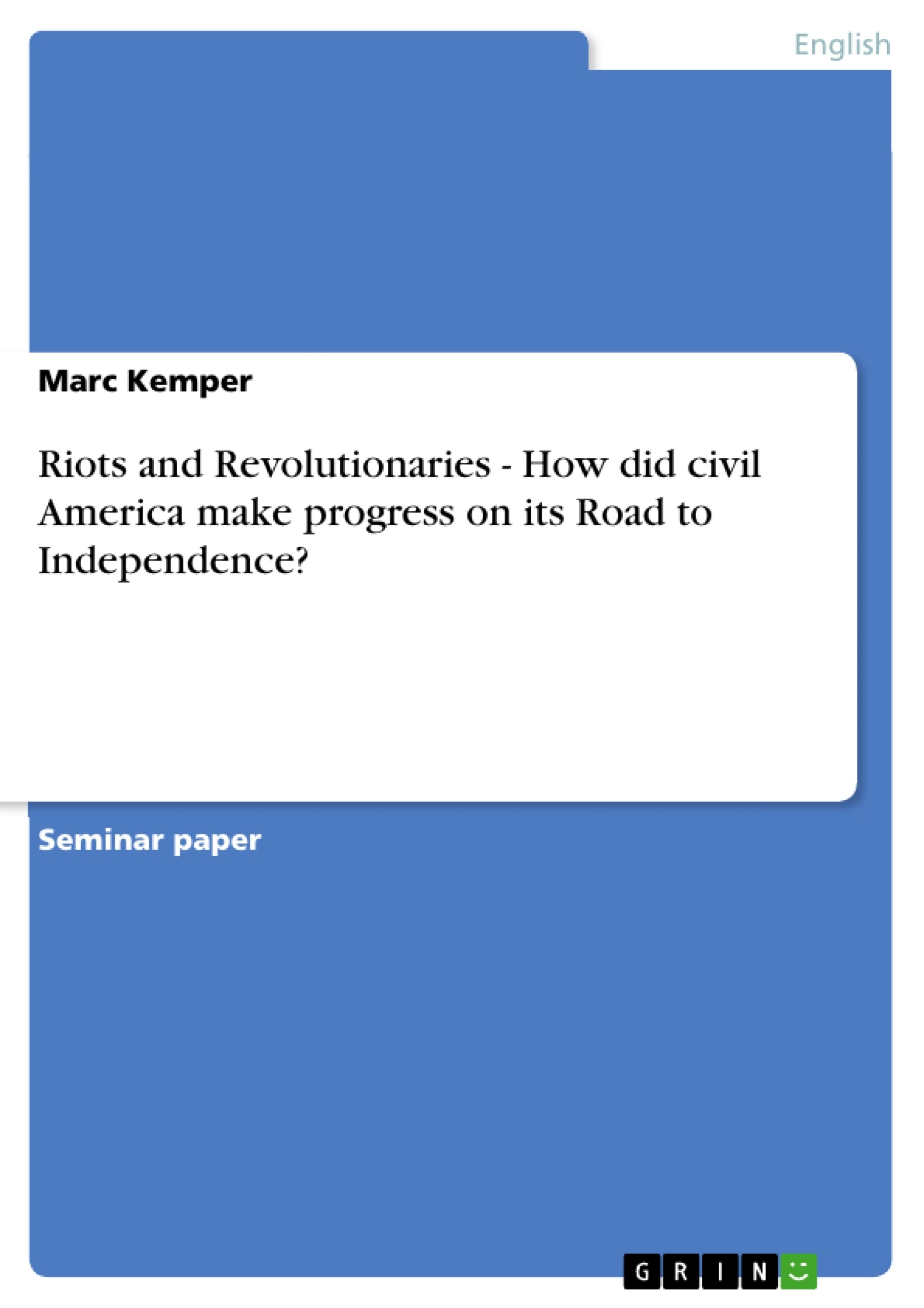Nowadays, fighting for freedom is a feeling that most people in the Western World know at best from television. Living in our heated up houses, we have the opportunity to choose for ourselves what we want to believe in, without being persecuted. When you compare the life of previous generations with today’s life, it is considerably easier now. In the lecture “Ideen- und Sozialgeschichte der USA” I heard about people fighting for their own lives, for their families and values. I have been fascinated by the civilians’ problems and their ways to solve them. The lecture did not offer so much time to study this special issue in particular, so for my great interest in people’s rebellions, I decided to study the role of civilians in the long struggle for independence - from the frustrating acts up to war and beyond. The result is what you are just holding in your hands today. I hope it will help you to understand the enormous pain, anger, and fear the people in the “New World” suffered from in the second half of the 18th century. At this time, America had been colonised by the British for almost two hundred years (the first Anglican settlement was Jamestown, Virginia, founded in 1607 by Captain John Smith ). At the beginning of the paper’s main part, I give a short summary of the important progresses up to the 1760s. In this period of time, I want to go in detail with the people’s sorrows upraised by the Crown and its provoking acts. I want to describe two of the deep-cutting acts passed by the English Crown in detail. I chose the so-called Townshend Program, the Tea Act, and the colonist’s reactions to them, to arrive in the following part at the beginning of the war, always paying attention to the role of civilians in special. The last part of my paper is meant to show the changes in daily life caused by the revolution, and its results. It should also show us what today’s society can learn from previous struggles for freedom and peace. Throughout the paper I proceed in a chronological way. The deepening sections - which are meant to specialise on the most illustrating events and processes involving the common people, or rather on the deeper backgrounds of historical events - must not be necessarily sequential.
Inhaltsverzeichnis (Table of Contents)
- Introduction
- Burdened by the British up to the brink of war
- The first acts aggravating civilians
- The Crown under pressure
- Escalating irritations – The road to war
- The Townshend Program
- Symbols of resistance
- A view on the Boston Massacre from both sides
- The Tea Act
- The Boston Tea Party
- Looking in the face of war
- How civilians got involved in military actions
- The Battles of Lexington and Concord
- The Second Continental Congress and the Continental Army
- The arming farmers
- Warmongering civilians - the militia
- Civil life in times of war
- Important publications and how the people assessed it
- The people's suffering
- Economic mobs
- How civilians got involved in military actions
- The beginning of the post-war-era
- The Rebellion of Daniel Shays
- Final results of the revolution
- While writing this paper
- Bibliography
- Webliography
Zielsetzung und Themenschwerpunkte (Objectives and Key Themes)
This paper examines the role of civilians in the American struggle for independence, exploring the frustrations and motivations that led to the American Revolution. The paper analyzes how ordinary people became involved in the conflict, the impact of the war on everyday life, and the lasting consequences of the revolutionary period.- The impact of British policies on colonial life.
- The evolution of civilian resistance to British rule.
- The transformation of civilian life during the Revolutionary War.
- The social and economic consequences of the Revolution.
Zusammenfassung der Kapitel (Chapter Summaries)
- The introduction establishes the context of the paper, highlighting the significance of understanding the role of civilians in the American Revolution. It also outlines the paper's structure and objectives.
- Chapter 2 delves into the escalating tensions between Britain and the American colonies. It examines the first acts of British legislation that aggravated colonists, including the Trade Act, the Woolens Act, the Molasses Act, and the Iron Act. The chapter also explores the impact of British involvement in wars, particularly the French-Indian War, and how it exacerbated colonial resentment.
- Chapter 3 focuses on the transition into the Revolutionary War and the active involvement of civilians. It discusses the Battles of Lexington and Concord, the formation of the Continental Army, and the mobilization of the militia. It also explores the social and economic consequences of war on civilian life, including the impact on publications, economic hardship, and the rise of mob violence.
Schlüsselwörter (Keywords)
The keywords for this paper include: American Revolution, British rule, colonial resistance, civilian involvement, War of Independence, social change, economic consequences, revolution, American history, and historical analysis.- Quote paper
- Marc Kemper (Author), 2002, Riots and Revolutionaries - How did civil America make progress on its Road to Independence?, Munich, GRIN Verlag, https://www.grin.com/document/118488



